The most mouthwatering Japanese street food
Japanese food is very popular worldwide, but street food in Japan is not a common thing compared to other Asian countries like Thailand, Taiwan or Vietnam.

Street food culture in Japan is quite different from some other parts of Asia, partially cultural and historical reasons mixed with strict hygiene standards and laws. Unlike Bangkok or Hanoi where eating on the side of the road is quite common and there are street food stalls open all year-round in fixed areas or night markets. In Japan, street food is closely associated to festivals and events, and food vendors tend to move around the country following all the varied local festivals.
If you visit any of these local festivals, you will find many pop-up food stalls, known as ‘Yatai’ in Japanese, selling a wide variety of easy, cheap but tasty food and snacks. These stalls also play a key role in creating a unique festival atmosphere. Street food sold at Yatai can vary between the seasons and regions of Japan, like Yaki Imo (Roasted Sweet Potato) which is usually sold in Winter and Kakigori (Japanese Shaved Ice) which is served in Summer.
Here are some of recommended mouthwatering street food dishes to sample while you are in Japan.
Takoyaki
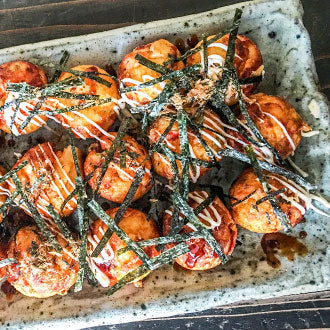
Takoyaki or ‘Octopus Balls’ are fried balls of dough made of a wheat flour-based batter and cooked in a special molded pan. It is normally filled with diced octopus, tempura scraps, pickled ginger and spring onions. Topped with Japanese mayonnaise, a savory Takoyaki sauce, fish flakes, and spring onion. It is also fun to watch how Takoyaki vendors make and skillfully flip the balls on the iron pan at a rapid pace using chopsticks. Takoyaki was created around the 1930s in Osaka and its popularity grew across the country. Now you can find Takoyaki almost everywhere.
Yakisoba
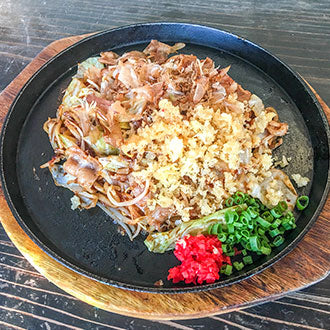
A classic Japanese stir fry noodles dish that you should not miss. Wheat noodles fried with mixed vegetables and pork and seasoned with a special Yakisoba sauce. The dish is usually topped with seaweed flakes, fish flakes, and pickled ginger. The gently sweet and deep savory flavors make Yakisoba a popular dish nationwide and is also an ideal dish for newbies to Japanese cuisine.
Yakitori
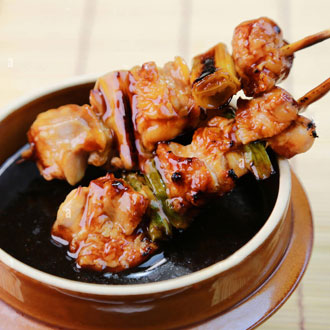
A Japanese style of grilled skewered chicken. Yakitori can be made from all parts of the chicken, such as the breasts, thighs, skin, liver and other innards that offer different taste and texture. The meat is typically seasoned or marinated with salt or Yakitori sauce, then skewing the meat with bamboo sticks before grilling over a charcoal fire. Served with the same dipping sauce which give the skewers more intense flavor. Yakitori vendors usually sell other meat and non-chicken skewers such as pork, beef, cherry tomatoes, shiitake mushrooms, and asparagus or enoki mushrooms wrapped in bacon. Yakitori is a very easy street food to cook at home and the result is as good as you have it at the food stalls in Japan. Try Enso’s Yakitori recipe here.
Ika Yaki

Ika Yaki refers to a whole grilled squid on a stick. The common flavor of Ika Yaki is a mildly sweet and salty taste and usually eaten at Japanese summer festivals. Fresh, tender squid is grilled over charcoal, seasoned and coated with grilling sauce, cooked to perfection then served with a slice of lemon or lime. The dish may look simple but the secret lies in the sauce they use when grilling, that makes Ika Yaki different from other grilled squid. The sauce is usually made from a mixture of grated fresh ginger, mirin, vegetable oil, soy sauce, miso paste and cooking sake.
Okonomiyaki
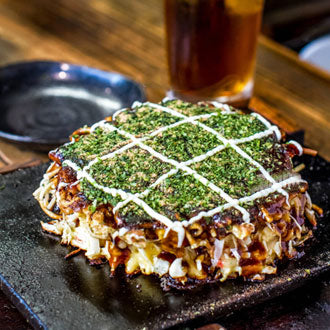
Okonomiyaki is a savory pancake dish made from wheat flour batter mixed with other ingredients like cabbage, meat, and seafood. Seasoning and topping with Okonomiyaki sauce, dried seaweed flakes, bonito flakes, Japanese mayonnaise, and pickled ginger. It is traditionally cooked on a flat griddle called Teppan. Okonomiyaki is a specialty of Osaka and Hiroshima, with two distinct main variants but has an equally great reputation.
Gyoza
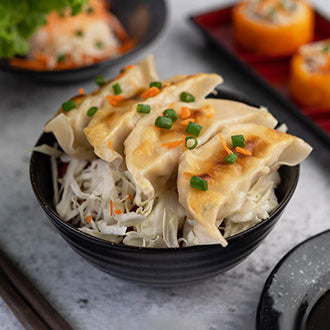
Gyoza or stuffed dumplings originally come from China, but the Japanese adopted and adapted the dish into their own recipe, called Gyoza. The Japanese version of the dumpling filling typically consists of ground pork, nira chives, green onion, cabbage, ginger, garlic, soy sauce and sesame oil. There are three common types of Gyoza served in Japan which are Yaki Gyoza (pan fried), Sui Gyoza (boiled in broth) and Age Gyoza (deep fried). And Yaki Gyoza is the most popular one. In Japan, Gyoza are usually eaten with a dipping sauce made of soy sauce, rice vinegar, and a bit of chili oil.
Imagawayaki

Imagawayaki is a thick pancake-like dessert made from a batter of eggs, flour, and sugar and cooked in a disk-shaped cast iron mold. It is usually cooked till crispy and traditionally filled with sweet red bean paste. But the modern version can use a variety of ingredients like vanilla custard, fruit custard, chocolate and matcha. Or even fill with savory fillings like different meats and vegetables, potatoes, curry, or cheese. Imagawayaki is a popular festival food in Japan and can be found across the country.
Taiyaki
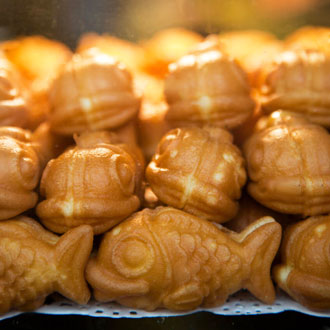
Another Japanese sweet treat which is similar to Imagawayaki. It is a pancake-like dessert filled with sweet red bean paste, but cooked in a fish-shaped mold, resembling Tai (red seabream) which is considered a symbol of good luck and how the name ‘Tai-yaki’ given. The common filling is red bean paste, but an alternative version can be made from other ingredients like vanilla custard, chocolate, cheese, or sweet potato.
Yaki Imo
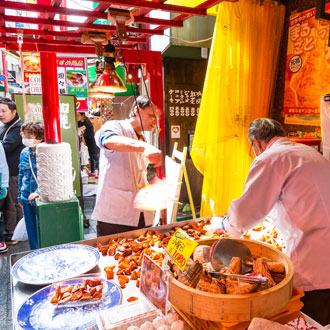
Yaki Imo or Roasted Sweet Potato is one of the oldest and most traditional of Japan’s street foods. Made from Satsuma-imo sweet potatoes, found only in Japan which makes Yaki Imo different and unique to this country. Typically roasted on a charcoal or wood fire that makes the potato skin nicely chewable, while the inside texture is soft and fluffy. Its taste is tender and sweet like caramel. Yaki Imo is traditionally sold by trucks or carts that drove around and advertise their goods through a loudspeaker. Although it is becoming harder to find that in a modern world. Yaki Imo is popularly eaten during wintertime to fight off the cold weather.
Tomorokoshi
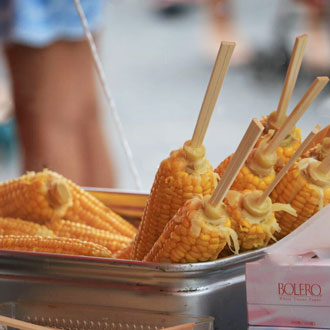
Tomorokoshi is a classic chargrilled corn on the cob and very popular in Japan, especially during summertime and festivals. The Japanese version is tasty and unique with a special local twist. It is grilled with miso, mirin, butter, and soy sauce, which gives the corn a sweet, savory and creamy flavor. The mixture of Tomorokoshi seasoning is very easy to make at home and quite a healthy snack for your weekend afternoon.
Kakigori
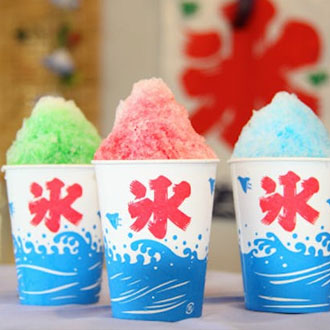
Kakigori or Japanese Shaved Ice is a popular sweet treat and is most welcome during a hot summer’s day or summer festivals. Even commonly found in many countries across Asia, but the Japanese version is unique and full of creativity. You can choose a variety of shaved ice flavors such as green tea, vanilla and lemon, topped with condensed milk or a variety of fruit syrups and decorated with anything from candy, mochi (sweet rice cakes), sweet red bean paste, jelly, or whipped cream.
If it is still not possible to travel to Japan and taste their street food. You may want to try cooking some dishes at home since they are not complicated to make if you have the right ingredients. You can get a few ideas from our easy Japanese recipes. Most of the ingredients can be found in any local Asian or Japanese store near you. But if not, you can shop online from our store here.

